

New Jersey 'dinosaur graveyard' may date back to the time of mass extinction. The widely accepted theory is that the reign of the dinosaurs came to an abrupt end 65 million years ago when an asteroid slammed into Earth.

While experts estimate 75 per cent of life was abruptly wiped out, no fossils from the precise time of this mass extinction have ever been found. Now hopes are high that a quarry behind a shopping centre in New Jersey may hold the remains of giant reptiles killed in the die-off - the first fossil evidence of the event to ever be found. Experts hope that a quarry (pictured) behind a shopping centre in New Jersey may hold the remains of giant reptiles killed as a result of the mass extinction that occurred when a meteor struck the Earth 65 million years ago. If proved, it would be the first fossil evidence of the event to ever be found Palaeontologists uncovered what has been described as a 'mass death assemblage' at a quarry pit in the Mantua Township in central New Jersey.
World's oldest sperm discovered in 17m-year-old Queensland fossil. The world's oldest fossilised sperm discovered in North QueenslandSteady rain of bat dropping perfectly preserved the fossilised spermThe sperm was longer than the ancient prawn it belonged toRiversleigh site considered one of world's richest fossil deposits By Louise Cheer Published: 09:45 GMT, 14 May 2014 | Updated: 12:01 GMT, 14 May 2014 The world's oldest fossilised sperm belonging to an ancient freshwater shrimp that dates back 17 million years has been discovered amidst preserved bat droppings in a North Queensland conservation park.
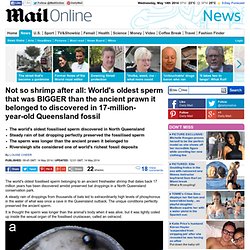
Lagerstätte. Types[edit] Palaeontologists distinguish two kinds:[1] Konzentrat-Lagerstätten (concentration Lagerstätten) are deposits with a particular "concentration" of disarticulated organic hard parts, such as a bone bed.

These Lagerstätten are less spectacular than the more famous Konservat-Lagerstätten. Burgess Shale. The Burgess Shale Formation, located in the Canadian Rockies of British Columbia, is one of the world's most celebrated fossil fields.[2] It is famous for the exceptional preservation of the soft parts of its fossils.

At 505 million years (Middle Cambrian) old,[3] it is one of the earliest fossil beds containing soft-part imprints. The rock unit is a black shale and crops out at a number of localities near the town of Field in Yoho National Park and the Kicking Horse Pass. Another outcrop is in Kootenay National Park 42 km to the south. History and significance[edit] The Burgess Shale was discovered by palaeontologist Charles Walcott on 30 August 1909,[4] towards the end of the season's fieldwork.[5] He returned in 1910 with his sons, daughter, and wife, establishing a quarry on the flanks of Fossil Ridge.
Maotianshan Shales. Hunsrück Slate. PyritizedFurcaster paleozoicus Stürtz, 1886 (8.5 cm long), a fossil brittle star (ophiuroid) from the Hunsrück Lagerstätte.
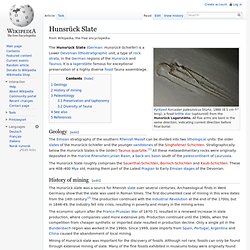
All five arms are bent in the same direction, indicating current direction before final burial. Gogo Formation. Sedimentology[edit] Unweathered sections of the Gogo Formation are made of siltstone, shale and calcarenite with numerous limestone concretions.
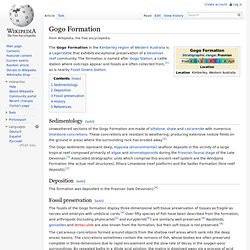
These concretions are resistant to weathering, producing extensive nodule fields on the ground in areas where the surrounding rock has eroded away.[2] Mazon Creek fossil beds. "Mazon Creek" redirects here.
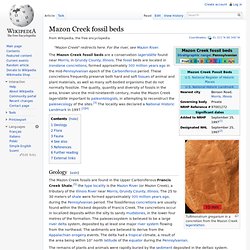
For the river, see Mazon River. Tullimonstrum gregarium in a concretion from the Mazon Creek lagerstätten. The Mazon Creek fossil beds are a conservation lagerstätte found near Morris, in Grundy County, Illinois. The fossil beds are located in ironstone concretions, formed approximately 300 million years ago in the mid-Pennsylvanian epoch of the Carboniferous period. These concretions frequently preserve both hard and soft tissues of animal and plant materials, as well as many soft-bodied organisms that do not normally fossilize.
Solnhofen Plattenkalk. The Solnhofen Plattenkalk, or Solnhofen limestone, is a Jurassic Konservat-Lagerstätte that preserves a rare assemblage of fossilized organisms, including highly detailed imprints of soft bodied organisms such as sea jellies.

The most familiar fossils of the Solnhofen Plattenkalk include the early bird Archaeopteryx preserved in such detail that they are among the most famous and most beautiful fossils in the world. The Solnhofen beds lie in the German state of Bavaria (Bayern), halfway between Nuremberg (Nürnberg) and Munich (München) and were originally quarried as a source of Lithographic limestone. Paleoenvironment and preservation[edit] During the Late Jurassic, this area was an archipelago at the edge of the Tethys Sea. This included placid lagoons that had limited access to the open sea and where salinity rose high enough that the resulting brine could not support life.
Paleobiota[edit] Cultural Goods made from Solnhofen Plattenkalk[edit] Yixian Formation. The Yixian Formation (simplified Chinese: 义县组; traditional Chinese: 義縣組; pinyin: Yìxiàn zǔ) is a geological formation in Jinzhou, Liaoning, People's Republic of China, that spans 11 million years during the early Cretaceous period.

It is known for its exquisitely preserved fossils, and is mainly composed of basalts interspersed with siliciclastic sediments.[1] List of fossil sites. Rhynie chert. Coordinates: The Rhynie chert is an Early Devonian sedimentary deposit exhibiting extraordinary fossil detail or completeness (a Lagerstätte).
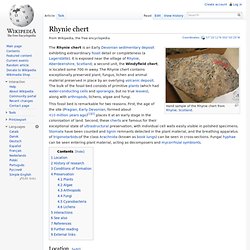
It is exposed near the village of Rhynie, Aberdeenshire, Scotland; a second unit, the Windyfield chert, is located some 700 m away. The Rhynie chert contains exceptionally preserved plant, fungus, lichen and animal material preserved in place by an overlying volcanic deposit. The bulk of the fossil bed consists of primitive plants (which had water-conducting cells and sporangia, but no true leaves), along with arthropods, lichens, algae and fungi. This fossil bed is remarkable for two reasons. Wheeler Shale. The Wheeler Shale (named by Charles Walcott) is a Cambrian (c. 507 Ma) fossil locality world famous[1] for prolific agnostid and Elrathia kingii trilobite remains (even though many areas are barren of fossils)[2] and represents a Konzentrat-Lagerstätten.
Varied soft bodied organisms are locally preserved, a fauna (including Naraoia, Wiwaxia and Hallucigenia) and preservation style (carbonaceous film) normally associated with the more famous Burgess Shale.[3] As such, the Wheeler Shale also represents a Konservat-Lagerstätten.[4] Together with the Marjum Formation and lower Weeks Formation, the Wheeler Shale forms 490 to 610 m (1,600 to 2,000 ft) of limestone and shale exposed in one of the thickest, most fossiliferous and best exposed sequences of Middle Cambrian rocks in North America.[5] Taphonomy & Sedimentology[edit] List of dinosaur-bearing rock formations.
Fossil. Fossilization processes Silicified (replaced with silica) fossils from the Road Canyon Formation (Middle Permian of Texas). The star-shaped holes (Catellocaula vallata) in this Upper Ordovician bryozoan represent a soft-bodied organism preserved by bioimmuration in the bryozoan skeleton.[7] The process of fossilization varies according to tissue type and external conditions. Permineralization Permineralization is a process of fossilization that occurs when an organism is buried. Casts and molds.